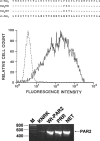Proteinase activated receptor 2: Role of extracellular loop 2 for ligand-mediated activation
- PMID: 10556949
- PMCID: PMC1571714
- DOI: 10.1038/sj.bjp.0702834
Proteinase activated receptor 2: Role of extracellular loop 2 for ligand-mediated activation
Abstract
1. Rat proteinase-activated receptor-2 (PAR2) variants were stably expressed in rat KNRK cells: (a) wild-type (wt) - PAR2; (b) PAR2PRR, with the extracellular loop 2 (EL-2) sequence P231E232E233mutated to PRR and (c) PAR2NET, with the EL-2 sequence, PEEV changed to NETL. Cell lines were evaluated for their sensitivity (calcium signalling) towards trypsin and the receptor-activating peptides, SLIGRL-NH2, SLIGEL-NH2, trans-cinnamoyl(tc)-LIGRLO-NH2, and SFLLR-NH2. 2. SLIGEL-NH2 exhibited low potency (1 : 200 relative to SLIGRL-NH2) in wild-type PAR2. Its activity was increased 5 fold in PAR2PRR, but it was inactive in PAR2NET. 3. In PAR2PRR, the potencies of SLIGRL-NH2, tc-LIGRLO-NH2, and SFLLR-NH2 were decreased by 80 - 100 fold. But, the potency of trypsin was decreased by only 7 fold. 4. In PAR2NET, highly homologous in EL-2 with proteinase-activated receptor-1 (PAR1), the potency of the PAR1-derived peptide, SFLLR-NH2, was reduced by 100 fold compared with wt-PAR2, whereas the potency of the PAR2-derived AP, SLIGRL-NH2 was reduced 10 fold. In contrast, the potency of trypsin in PAR2NET was almost the same as in wt-PAR2. 5. We conclude that the acidic EL-2 tripeptide, PEE, in PAR2 plays an important role in governing agonist activity. 6. The data obtained with the PEEV-->NETL mutation suggested: (a) that SLIGRL-NH2 and SFLLR-NH2 interact in a distinct manner with PAR2 and (b) that SFLLR-NH2 may interact differently with PAR2 than it does with PAR1. 7 The differential reductions in the potencies of SLIGRL-NH2, compared with trypsin in the PAR2PRR and PAR2NET cell lines point to differences between the interactions of the trypsin-revealed tethered ligand and the free receptor-activating peptide with PAR2.
Figures





References
-
- AL-ANI B., SAIFEDDINE M., HOLLENBERG M.D. Detection of functional receptors for the proteinase-activated receptor-2-activating polypeptide, SLIGRL-NH2 in rat vascular and gastric smooth muscle. Can. J. Physiol. Pharmacol. 1995;73:1203–1207. - PubMed
-
- AL-ANI B., SAIFEDDINE M., KAWABATA A., RENAUX B., MOKASHI S., HOLLENBERG M.D.Proteinase activated receptor-2 (PAR2): Development of a ligand binding assay correlating with activation of PAR2 by PAR1- and PAR2-derived peptide ligands J. Pharmacol. Exp. Ther. 1999. in press - PubMed
-
- BLACKHART B.D., EMILSSON K., NGUYEN D., TENG W., MARTELLI A.J., NYSTEDT S., SUNDELIN J., SCARBOROUGH R.M. Ligand cross-reactivity within the protease-activated receptor family. J. Biol. Chem. 1996;271:16466–16471. - PubMed
-
- CHAO B.H., KALKUNTE S., MARAGANORE J.M., STONE S.R. Essential groups in synthetic agonist peptides for activation of the platelet thrombin receptor. Biochemistry. 1992;31:6175–6178. - PubMed
Publication types
MeSH terms
Substances
LinkOut - more resources
Full Text Sources
Other Literature Sources

